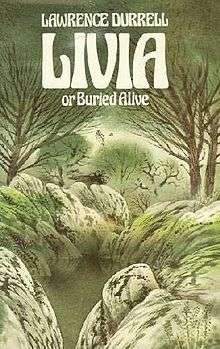Livia (novel)
 First edition | |
| Author | Lawrence Durrell |
|---|---|
| Country | United Kingdom |
| Language | English |
| Series | The Avignon Quintet |
| Publisher | Faber & Faber (UK) |
Publication date | 1978 |
| Media type | Print (Hardback & Paperback) |
| Pages | 265 p. |
| ISBN | 0-571-11297-8 |
| OCLC | 4340729 |
| 823/.9/12 | |
| LC Class | PZ3.D9377 Li PR6007.U76 |
| Preceded by | Monsieur |
| Followed by | Constance |
Livia, or Buried Alive (1978), is the second volume in British author Lawrence Durrell's The Avignon Quintet, published from 1974 to 1985. Durrell has described the novels as "roped together like climbers on a rockface, but all independent . . . a series of books through which the same characters move for all the world as if to illustrate the notion of reincarnation."[1] The first novel of the quincunx, Monsieur, received the James Tait Black Memorial Prize in 1974.
Plot summary
The protagonist is novelist Aubrey Blanford, introduced as a character 50 pages before the end of the first novel of the quintet, Monsieur. Sisters Livia and Constance, who briefly figured at the end of Monsieur, are featured in this novel, as well as their brother Hillary, Constance's husband Sam, and a number of other new characters. The novel is set chiefly on a hillside farm in Provence before World War II. The characters take a barge down the Rhône River to the nearby city of Avignon, which is well described and celebrated by the author.[1]
Blanford's fictional creation, author Robin Sutcliffe, figures in this novel. (He was described as having died since the previous novel.) His "commonplace book full of uncommonplace and conflicting thoughts supplies a sort of preposterously punning Greek chorus to the present volume."[1]
Reception
Critic Alastair Forbes in the New York Times wrote, "If in "Livia" he [Durrell] seems scarcely up to form, much of his writing -- not least his jokes and puns, both good and bad -- can still give its customary pleasure."[1] But he describes as "lamentable" a lengthy "set piece" set in a brothel in Avignon.[1]
References
- 1 2 3 4 5 Alastair Forbes, "Dwarves Abounding in Provence", New York Times, 22 April 1979; accessed 17 October 2016
External links
- The International Lawrence Durrell Society Official website of ILDS
- Durrell 2012: The Lawrence Durrell Centenary, Centenary event website and Durrell Journal
- The Durrell School of Corfu, dedicated to the history, arts and culture of the region, as well as the works and lives Lawrence and Gerald Durrell
- The Literary Encyclopedia
- The Lawrence Durrell Archives